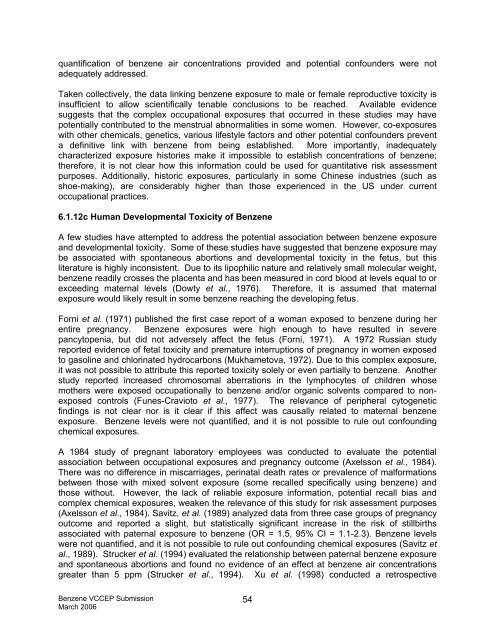(VCCEP) Tier 1 Pilot Submission for BENZENE - Tera
(VCCEP) Tier 1 Pilot Submission for BENZENE - Tera
(VCCEP) Tier 1 Pilot Submission for BENZENE - Tera
You also want an ePaper? Increase the reach of your titles
YUMPU automatically turns print PDFs into web optimized ePapers that Google loves.
quantification of benzene air concentrations provided and potential confounders were not<br />
adequately addressed.<br />
Taken collectively, the data linking benzene exposure to male or female reproductive toxicity is<br />
insufficient to allow scientifically tenable conclusions to be reached. Available evidence<br />
suggests that the complex occupational exposures that occurred in these studies may have<br />
potentially contributed to the menstrual abnormalities in some women. However, co-exposures<br />
with other chemicals, genetics, various lifestyle factors and other potential confounders prevent<br />
a definitive link with benzene from being established. More importantly, inadequately<br />
characterized exposure histories make it impossible to establish concentrations of benzene;<br />
there<strong>for</strong>e, it is not clear how this in<strong>for</strong>mation could be used <strong>for</strong> quantitative risk assessment<br />
purposes. Additionally, historic exposures, particularly in some Chinese industries (such as<br />
shoe-making), are considerably higher than those experienced in the US under current<br />
occupational practices.<br />
6.1.12c Human Developmental Toxicity of Benzene<br />
A few studies have attempted to address the potential association between benzene exposure<br />
and developmental toxicity. Some of these studies have suggested that benzene exposure may<br />
be associated with spontaneous abortions and developmental toxicity in the fetus, but this<br />
literature is highly inconsistent. Due to its lipophilic nature and relatively small molecular weight,<br />
benzene readily crosses the placenta and has been measured in cord blood at levels equal to or<br />
exceeding maternal levels (Dowty et al., 1976). There<strong>for</strong>e, it is assumed that maternal<br />
exposure would likely result in some benzene reaching the developing fetus.<br />
Forni et al. (1971) published the first case report of a woman exposed to benzene during her<br />
entire pregnancy. Benzene exposures were high enough to have resulted in severe<br />
pancytopenia, but did not adversely affect the fetus (Forni, 1971). A 1972 Russian study<br />
reported evidence of fetal toxicity and premature interruptions of pregnancy in women exposed<br />
to gasoline and chlorinated hydrocarbons (Mukhametova, 1972). Due to this complex exposure,<br />
it was not possible to attribute this reported toxicity solely or even partially to benzene. Another<br />
study reported increased chromosomal aberrations in the lymphocytes of children whose<br />
mothers were exposed occupationally to benzene and/or organic solvents compared to nonexposed<br />
controls (Funes-Cravioto et al., 1977). The relevance of peripheral cytogenetic<br />
findings is not clear nor is it clear if this affect was causally related to maternal benzene<br />
exposure. Benzene levels were not quantified, and it is not possible to rule out confounding<br />
chemical exposures.<br />
A 1984 study of pregnant laboratory employees was conducted to evaluate the potential<br />
association between occupational exposures and pregnancy outcome (Axelsson et al., 1984).<br />
There was no difference in miscarriages, perinatal death rates or prevalence of mal<strong>for</strong>mations<br />
between those with mixed solvent exposure (some recalled specifically using benzene) and<br />
those without. However, the lack of reliable exposure in<strong>for</strong>mation, potential recall bias and<br />
complex chemical exposures, weaken the relevance of this study <strong>for</strong> risk assessment purposes<br />
(Axelsson et al., 1984). Savitz, et al. (1989) analyzed data from three case groups of pregnancy<br />
outcome and reported a slight, but statistically significant increase in the risk of stillbirths<br />
associated with paternal exposure to benzene (OR = 1.5, 95% CI = 1.1-2.3). Benzene levels<br />
were not quantified, and it is not possible to rule out confounding chemical exposures (Savitz et<br />
al., 1989). Strucker et al. (1994) evaluated the relationship between paternal benzene exposure<br />
and spontaneous abortions and found no evidence of an effect at benzene air concentrations<br />
greater than 5 ppm (Strucker et al., 1994). Xu et al. (1998) conducted a retrospective<br />
Benzene <strong>VCCEP</strong> <strong>Submission</strong><br />
March 2006<br />
54





